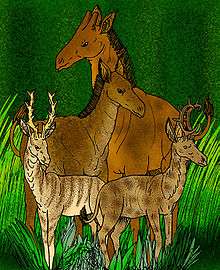Climacoceratidae
| Climacoceratidae Temporal range: Miocene | |
|---|---|
 | |
| Comparison of Palaeotragus (center) with Climacoceras | |
| Scientific classification | |
| Kingdom: | Animalia |
| Phylum: | Chordata |
| Class: | Mammalia |
| Order: | Artiodactyla |
| Superfamily: | Giraffoidea |
| Family: | †Climacoceratidae Hamilton, 1978 |
| Genera | |
| |
Climacoceratidae ("ladder horns") is a family of superficially deer-like artiodactyl ungulates which lived in the Miocene era in Africa. They are close to the ancestry of giraffes, with some genera, such as Prolibytherium, originally identified as being giraffes.
The climacoceratids, namely members of what is now the type genus Climacoceras, were originally placed within the family Palaeomerycidae, and then within Giraffidae. In 1978, W. D. Hamilton erected a new family, placing it close to Giraffidae.
They differ from giraffes in that their antler-like ossicones are derived from different bones.
References
- MacInnes, D. G. 1936, "A new genus of fossil deer from the Miocene of Africa", Journal of the Linnean Society, Zoology 39: 521-530.
- Hamilton, W. R., 1978, "Cervidae and Palaeomerycidae", 495-508, in Maglio, V. J. & Cooke, H. B. S., (eds.) "Evolution of African mammals", Harvard University Press, Cambridge, Massachusetts & London, England, 1978, xiv-641
This article is issued from Wikipedia - version of the 11/16/2016. The text is available under the Creative Commons Attribution/Share Alike but additional terms may apply for the media files.